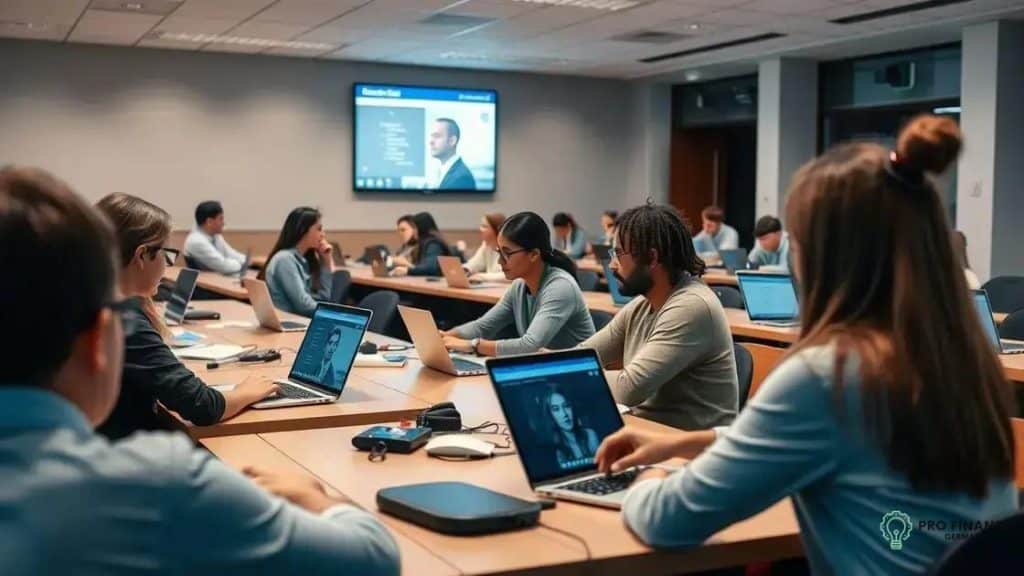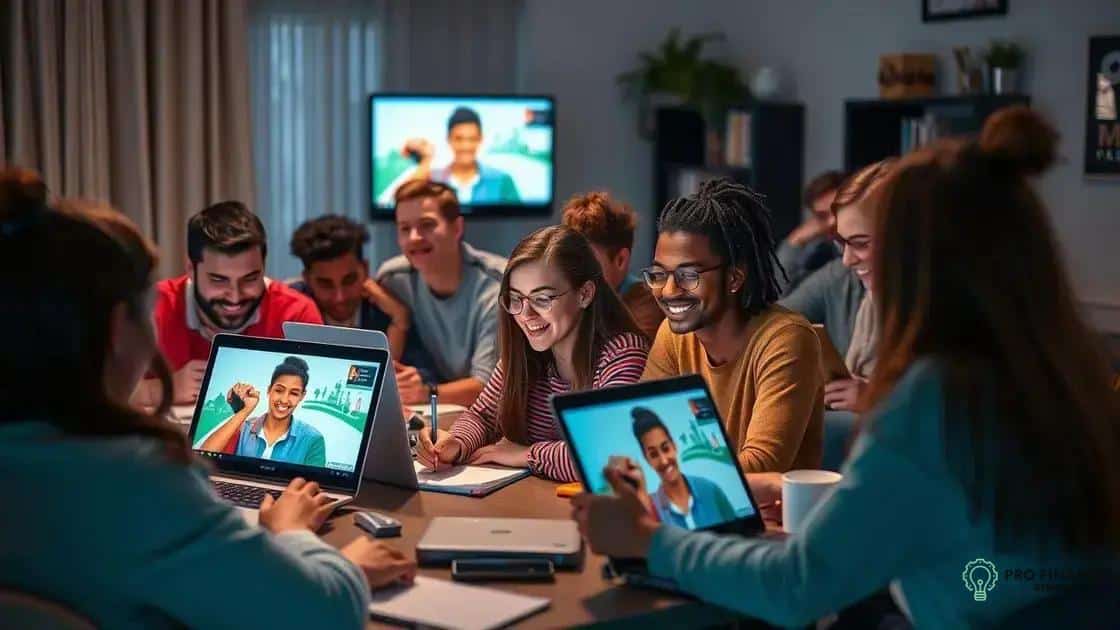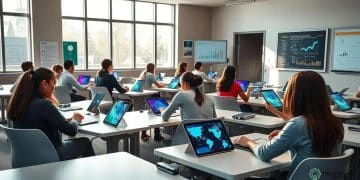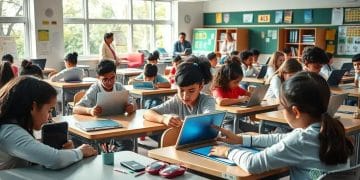The effect of remote learning on higher education quality

The effect of remote learning on higher education quality has led to significant changes, including increased technology integration, flexible learning models, and a focus on student well-being and innovative assessment methods.
The effect of remote learning on higher education quality is a topic that continues to spark debate. Have you noticed how universities are adapting their teaching methods? This exploration seeks to uncover the nuances of this transformation.
Understanding remote learning
Understanding remote learning has become crucial in today’s educational landscape. As more institutions shift to online platforms, it’s essential to grasp its implications for students and educators alike.
One of the key aspects of remote learning is accessibility. Many students can now attend classes from anywhere, which promotes inclusivity. However, there are challenges, such as the need for reliable internet and technology. These factors can impact the effectiveness of online education.
Benefits of Remote Learning
Remote learning offers unique benefits that traditional classroom settings may lack. Here are some advantages:
- Flexibility: Students can learn at their own pace and on their own schedule.
- Broader Course Options: Online platforms provide access to a variety of courses across different subjects.
- Eliminating Commute: This format saves time and reduces transportation costs.
- Personalized Learning: Educators can tailor lessons to individual student needs.
Moreover, understanding the role of technology in facilitating remote learning is crucial. Tools like video conferencing, digital classrooms, and interactive software enhance the learning experience. These technologies foster communication between teachers and students, making it easier to share knowledge and resources.
Despite the advantages, some students struggle with motivation and engagement in a remote setting. Many of them miss the in-person interaction that traditional classrooms provide. To combat this, educators are exploring innovative ways to keep students engaged.
Challenges in Remote Learning
Remote learning isn’t without its challenges. Some common issues include:
- Technical Difficulties: Students may encounter issues with internet connectivity or software glitches.
- Isolation: The lack of social interaction can lead to feelings of loneliness.
- Diverse Learning Styles: Adapting lessons to fit every student’s needs can be tough.
When educators understand these challenges, they can better support their students. Creating a community feeling in online classes is essential for fostering relationships and collaboration.
In conclusion, understanding remote learning is paramount as we navigate this shift in education. By addressing its benefits and challenges, both students and educators can work towards maximizing the remote learning experience.
Impact on student engagement

The impact on student engagement during remote learning is a critical concern. Engaging students online can be quite different from traditional classroom settings. Many students find it harder to stay focused when learning from home.
One significant factor is the absence of physical presence. Students often miss the social interactions that come with being in a classroom. This separation can lead to feelings of isolation, which may affect their motivation and participation. To combat this, teachers are striving to create interactive and engaging online experiences.
Strategies to Enhance Engagement
Educators are employing various strategies to improve student engagement in remote settings. These include:
- Interactive Lessons: Incorporating quizzes and polls keeps students actively involved.
- Group Work: By using breakout rooms, students can collaborate and discuss in smaller groups.
- Regular Feedback: Providing timely feedback helps students feel supported and motivated.
- Gamification: Using game-like elements in lessons can make learning fun and engaging.
Another aspect of student engagement is the use of technology. Many platforms offer tools to facilitate interaction, such as chat features, video discussions, and virtual whiteboards. These tools create a dynamic and participatory environment, which encourages students to express their thoughts and ideas.
However, not all students may respond positively to the same approaches. It’s essential to recognize the diverse needs of learners. Tailoring strategies to fit different learning styles can boost engagement. For instance, some students may prefer visual content, while others thrive on verbal communication.
Monitoring and Adjustment
It is crucial for educators to continuously monitor how students are responding. They may need to adjust their methods based on feedback and observation. Regular check-ins can help gauge student engagement levels and identify who may need extra support.
Changes in assessment methods
The changes in assessment methods during remote learning have been significant. With the move to online education, educators have had to adapt traditional testing formats to suit the virtual environment. This shift has raised questions about fairness, effectiveness, and integrity in assessments.
Many schools and universities are exploring alternative methods to evaluate student performance. One popular approach is the use of open-book exams, which allow students to reference materials while answering questions. This format aims to assess understanding rather than memorization, aligning with the learning objectives of remote education.
Innovative Assessment Techniques
Some innovative techniques that have emerged include:
- Project-Based Assessments: Students demonstrate their learning through projects that require critical thinking and creativity.
- Online Quizzes: Short quizzes administered through digital platforms can provide instant feedback and track progress.
- Peer Assessments: Involving students in evaluating each other’s work fosters collaboration and deeper understanding.
Moreover, educators are utilizing formative assessments to provide ongoing feedback. This approach helps identify areas where students are struggling, allowing for timely interventions. Regular check-ins can include discussions, reflections, and interactive activities that keep students engaged.
Technical considerations also play a crucial role in assessing students during remote learning. Ensuring all students have access to the necessary technology is vital for fair assessments. Additionally, addressing issues of academic integrity is important. Schools are implementing measures such as proctored exams and plagiarism detection software to maintain the validity of assessments.
Adapting to Diverse Learning Needs
It’s essential to recognize that not all students learn in the same way. Therefore, assessments should accommodate various learning styles. Allowing students to choose how they demonstrate their knowledge can lead to more meaningful evaluations. This flexibility enables students to leverage their strengths, ultimately enhancing learning outcomes.
Challenges faced by educators
The challenges faced by educators during the shift to remote learning are vast and complex. Many teachers have had to adapt to new technologies and teaching methods, navigating obstacles they had never encountered before.
One major challenge is ensuring that all students have access to reliable technology and internet connections. In many cases, students come from different backgrounds, and the digital divide can hinder effective learning. Without proper access, some students may feel left out, affecting their performance and engagement.
Adapting to New Teaching Methods
Moreover, teachers have had to change their assessment techniques and class formats. This adaptation requires learning new tools, which can be overwhelming. Many educators felt unprepared to deliver lessons online. They must figure out how to create engaging content that translates well from classroom to screen.
- Technology Integration: Teachers must become familiar with various digital platforms, which may take time and training.
- Engagement Strategies: Finding ways to keep students interested in a virtual setting poses a significant challenge.
- Work-Life Balance: Educators often find themselves working longer hours as they prepare lessons and manage online classrooms.
Another concern is maintaining student engagement and motivation. Without physical presence, some students may lose focus or become distracted. Educators are experimenting with interactive lessons and group work to create a sense of community and keep students involved.
Addressing Emotional and Mental Health
Educators are also tasked with recognizing the emotional and mental health needs of their students. The pandemic has brought on anxiety and stress for many. Teachers need to provide support while balancing their own challenges.
Regular check-ins and creating a supportive classroom environment can help students feel connected. This approach promotes healthier communication and fosters a positive learning atmosphere. Educators must also take care of their well-being, as the demands of remote teaching can lead to burnout.
Future of higher education post-pandemic
The future of higher education post-pandemic looks promising yet uncertain. As institutions begin to adapt, they are rethinking traditional models of teaching and learning. The shift to remote learning has opened new possibilities for flexibility and accessibility.
Many universities are now offering hybrid models, combining in-person and online classes. This blend allows for greater choice and convenience for students. Additionally, it can help alleviate some challenges related to campus size and resources. As a result, more students may have the opportunity to pursue higher education without the constraints of geographical limitations.
Increased Focus on Technology
Technology will play a significant role in shaping the future of education. Learning management systems, virtual reality, and artificial intelligence are expected to enhance educational experiences. These tools can provide personalized learning experiences by adapting content to fit students’ individual needs.
- Virtual Classrooms: Online platforms will likely continue to evolve, offering interactive features that keep students engaged.
- Data-Driven Insights: Institutions can use data analytics to monitor student performance and improve outcomes.
- Global Collaboration: Students can connect with peers and educators worldwide, widening their perspectives.
Another critical aspect of the post-pandemic future is the emphasis on mental health and well-being. As educators recognize the challenges faced by students, providing resources and support systems will be vital. Creating an environment where students feel safe and supported is crucial for fostering academic success.
Redefining Assessment and Accreditation
As education evolves, so too must assessment methods. Institutions may rethink how they evaluate student success, moving towards more holistic approaches. Assessments could focus on real-world applications and skills rather than just standardized tests.
Furthermore, accreditation processes may adapt to recognize innovative learning models. This evolution could lead to more diverse offerings and educational paths, enabling students to choose programs that align with their career goals.
In summary, the future of higher education post-pandemic is likely to be marked by advancements in technology, a greater focus on well-being, and a transformation in how we assess learning. These changes will require collaboration among educators, institutions, and students to ensure a successful transition into the new educational landscape.
FAQ – Frequently Asked Questions about the Future of Higher Education Post-Pandemic
What is the future of higher education after the pandemic?
The future of higher education is expected to be more flexible, incorporating hybrid models that blend online and in-person learning.
How will technology impact education moving forward?
Technology will enhance education by providing innovative tools, such as virtual classrooms and personalized learning experiences.
What measures are being taken to support student well-being?
Institutions are focusing on mental health resources and creating supportive environments to address the emotional needs of students.
How are assessment methods changing in higher education?
Assessment methods are evolving to include more holistic approaches, such as project-based evaluations and continuous feedback.





